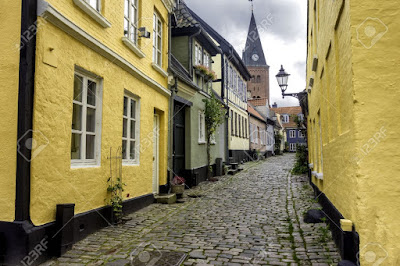“JUST living is not enough…one must have sunshine, freedom, and a little flower.”
The Complete Fairy Tales by famous Danish writer H.C. Andersen weaves those words so beautifully that it becomes indelible in the hearts and minds of the Danes.
The annual World Happiness Report, which ranks 156 countries by their happiness levels, consistently places Denmark on top. Then this year, Aalborg, a city in the north of Denmark, steals the spotlight as the happiest city in Europe. It tops the Eurobarometer, an annual report by the European Commission surveying the quality of life amongst European citizens.
“Live in Europe’s happiest city!” A real estate poster caught my eye as I was walking along the city center. I thought about it and looked at what was going on: countless bikers on their way to work, shoppers calmly making their way in and out of stores, a mother sitting inside a coffee shop while her baby was outside sleeping in a baby carriage (I saw your jaw drop but really, they do that here) and cars almost floating in the graceful rush of traffic, no honking and no over-speeding. Everything holds its elegant flow, as if the city is struck by magic.
Aalborg is 139 square kilometres and lies in North Jutland (northwest of Denmark). It’s the fourth most populous city in the country, having around 109 thousand people in a country of five million citizens.
People and activities
Like the rest of the Danes, the people of Aalborg are likeable with their respect for each other, their obedience to rules of the land, their knowledge and support of political affairs, and their seemingly, at surface-level, weird but justifiable ways of having fun. Justifiable because really, it’s difficult not to like the brewers of the world’s best beer, the creators of Lego, and the producers of so much cheese, butter, and bacon. People of Aalborg are peaceable and level-headed, but also know how to let it all out for fun.
Take the Aalborg Carnival, for example. The street is everybody’s stage and performances range from best-performance-ever to best-drunk-performance-ever. The fun can go over-the-top, that it’s normal to find people sleeping on the streets the day after the carnival, still wearing their costumes, albeit dirty and smelly, and still holding a glorified beer bottle in their hands. This carnival is celebrated annually every May and is one of the best in the world, as people don their weirdest, craziest, funniest, most colourful and most unique costumes for this celebration that draws an average of 250,000 participants.
Then there is Aalborg’s Oktoberfest, which, unsurprisingly, brings numerous participants in extreme joviality that they tend to dance above tables and chairs, then slide and fall from them afterwards. The culprits – must be the pumped-up music and beer, yes, beer, the eternal culprit.
Beer aside, there is the Aalborg Halfmarathon which draws around 5,000 participants and the recently concluded Aalborg Pride that joyfully and creatively appeals for human rights and diversity for all.
On normal days, people prioritize coziness of being stress-free, in Danish this is called hygge, which really does not have a direct translation in English, but refers to the times when you feel cozy, relaxed, happy. It is basically the art of being contented, thus, they light candles to put a nice glow in their homes or have evening coffee with chocolates.
Attractions, nightlife, history
A natural crowd pleaser is the newly-renovated waterfront at the Limfjord. There are benches facing the harbour and a much wider space to do whatever one feels like doing. Included in the city’s new renovation is the transformation of one part of the harbour into a gorgeous recreational and cultural area with the Utzon Center as the hub for innovation, architecture, art and design and Musikkens Hus (House of Music) which contains a music hall for the Aalborg Symphony Orchestra, the Royal Academy of Music, and Danish Jazz Center.
Aalborg can be toured in a day or two as almost everything happens in the city center and the waterfront which is a 10-minute walk from each other. Connected to the harbour are two main shopping streets Algade and Bispengade which also connect to Jomfru Ane Street, a street packed with restaurants and bars and transforms into a bewitching area for people on a night out. It houses rows and rows of bars and night clubs catering to different kinds of night owls from stand-up comedies to theme parties, from fashion shows to cultural events to just about any kind of musical show. It is here that one experiences Euro Pop at its finest and wildest.
To understand a bit of Aalborg’s history, historical sites are aplenty in Lindholm Høje, which includes burial sites for two very important eras in Danish history – the Germanic Iron Age and the Vikings Age.
The Springeren Marine Experience Museum at the west of the city exhibits the technology and information behind the Port of Aalborg and the Aalborg Shipyard. The main attraction of the museum is its display of the submarine called Springeren, the last Danish constructed and Danish built submarine. Additional historical finds are available at the Franciscan Monastery which is located three meters below one of the busiest places in the city. It displays well-preserved Medieval Ruins of the Franciscan Monastery during the 1200s. One can reach the monastery through an elevator located beside the high-end mall of Salling’s.
Stunning surrounding areas
Source: Cathy Perez
http://www.sunstar.com.ph/cebu/lifestyle/2016/07/21/aalborg-europes-happiest-city-486474





Sicherer Edelstahl-Vorratsbehälter
ReplyDeleteHochwertige Induktions-Edelstahl-Kochtöpfe
Stahl Kochtopf Balancia
Kochgeschirr aus Edelstahl
Kochtopf aus Edelstahl
bester Kochtopf aus Edelstahl